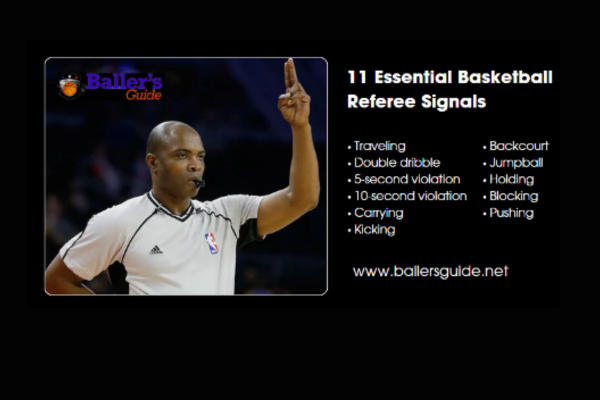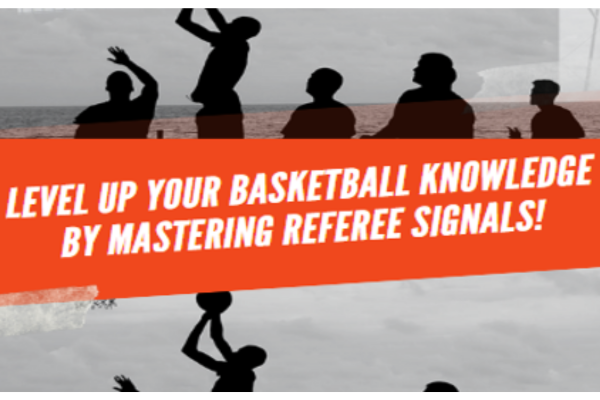
If you’ve ever found yourself watching a basketball game and wondering what all those hand gestures from the referees really mean, you’re not alone. Whether you’re a player, coach, or fan, those hand signals can seem like a confusing language all their own. From the classic “traveling” call to more complex fouls, understanding referee signals is crucial for anyone involved in the game.
In this blog, we’ll break down 11 essential basketball referee signals and explain their meanings, helping you navigate the court with confidence.
Let’s dive in!
Table of Contents
What is the role of the referee in basketball?
A referee is also called an official in various competitions and sports. It’s their responsibility to enforce the rules of the game and sportsmanship decisions.
Since the sport usually has various rules and decisions, the referee is there to make sure that everyone plays fair and square.
What are basketball referee signals?
Basketball referee signals are hand gestures used by officials to communicate rule violations or player actions that impact the game. These signals help grab the attention of players and the audience, ensuring clear and effective communication during the game.
11 basketball referee signals and their meaning

There are a lot of basketball referee signals, so here are some of the signals you will often encounter during a game:
- Traveling: One of the most common basketball referee signals, traveling occurs when the referee makes a rolling or spinning motion with both arms. It means the ball handler took too many steps without dribbling the ball. As a result, the offensive team loses the ball, so make sure not to make this mistake.
- Double Dribble: If the referee mimics the motion of dribbling with both hands, it means the player dribbled with both hands at once. Another form of double dribbling happens when a player picks up their dribble and then dribbles again. Either way, it’s a turnover for the offensive team, so be mindful when handling the ball.
- 5-Second Violation: When the referee holds up five fingers, it indicates the inbounder took more than five seconds to inbound the ball. Remember, the team only has five seconds to pass the ball in from the sideline.
- 10-Second Violation: The referee will hold up 10 fingers if a team takes more than 10 seconds to advance the ball past half court. Once the ball is inbounded, the offensive team has 10 seconds to cross the midcourt line.
- Carrying: This signal is often seen during younger games. When the referee shows an open palm facing up, it means the ball handler is palming the ball or scooping it underneath instead of properly dribbling. This results in a turnover, so make sure to maintain proper dribbling form.
- Kicking: If the referee performs a kicking motion with one foot, it means a player intentionally kicked the ball. The play is stopped, and possession of the ball is awarded to the other team through an out-of-bounds throw-in.
- Backcourt Violation: The referee will sway their arm with the palm up beyond hip level and then lower it with the palm down to signal a backcourt violation. This means the offensive team took the ball back across the midcourt line after it had already crossed. Always ensure the ball stays in the frontcourt after crossing midcourt.
- Jump Ball: When the referee raises two thumbs up, it means two opposing players have possession of the ball at the same time, resulting in a jump ball. The players will compete to determine who gets possession of the ball.
- Holding: If the referee grabs their wrist, it indicates that a defender held an offensive player. This is a personal foul on the defender, so always be cautious with where and how you use your hands during defensive plays.
- Blocking: The referee places both hands on their hips when they call a blocking foul. This means the defender failed to establish position and moved in the way of the offensive player without setting their feet. Depending on the situation, this may result in free throws or an out-of-bounds possession for the offensive team.
- Pushing: If the referee makes a shoving motion with their arms, it means a player pushed another player out of the way. This results in a personal foul and a turnover of possession to the other team. Be cautious of your physicality when guarding or trying to move past a player.
Knowing these signals can help you understand the flow of the game and keep you aware of what’s happening on the court. Keep these in mind the next time you’re watching or playing!
How a Referee Signals a Goal:
Referees use specific hand signals to indicate whether a shot counts as two or three points during the game.
- Two-Point Shot: The referee points two fingers while extending one arm parallel to the floor.
- Three-Point Shot: The referee extends both arms upwards, with fingers pointing to indicate a three-point score.
These signals confirm that the shot counts toward the score.
Why Do Basketball Refs Wave Their Arms?
Referees wave their arms to indicate that a shot does not count. This typically happens when a foul occurs during the shot attempt. The referee will check if the foul happened while shooting; if it didn’t, the shot is invalid.
Frequently Asked Questions

Why is it important to understand basketball referee signals?
Knowing the signals helps players, coaches, and fans understand game calls, improve decision-making, and ensure fair play on the court.
How can players avoid common fouls?
Players should focus on good defense, maintaining proper positioning, and avoiding unnecessary physical contact to prevent fouls like holding and pushing.
What should players do if they disagree with a referee’s call?
Players should stay calm and respectful, asking for clarification after the game or during timeouts instead of arguing during play.
What happens if a player commits a violation?
Committing violations like double dribbling or traveling results in a turnover, and the opposing team gains possession of the ball.
How does understanding referee signals improve team strategy?
It helps players and coaches anticipate calls, adjust strategies quickly, and avoid mistakes, ultimately improving performance.
Do referees use the same signals in all games?
Yes, referee signals are standardized, making it easy for players and coaches to recognize and understand calls across all levels of play
Conclusion

Knowing the basketball referee signals is really helpful for players, coaches, and fans. These hand gestures help everyone understand what’s going on in the game. For players, it’s important to know these signals so they can make the right choices and avoid mistakes.
Understanding the rules makes the game fair and keeps everyone safe on the court. By getting familiar with these signals, players can stay confident, make better decisions, and know what’s happening around them.
Next time you’re on the court or watching a game, paying attention to these signals can make things much clearer.
Explore the Beginner’s Guide to Getting Started in Basketball and Master the Basics of the Game!
